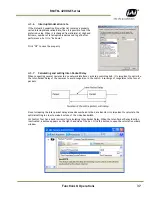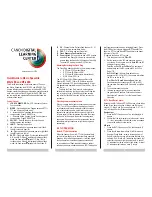
Operation 23
RM/TM-4200GE Series
3.2.6
Interpolation Software
The color interpolation can be performed in the framegrabber or by using the host computer’s CPU. Most major
framegrabbers with processing capability provide tools for color interpolation. Software vision packages also
provide color interpolation capability, but speed and performance may be determined by the PC’s resources
and by the complexity of the interpolation routine.
3.2.7
Color Interpolation
The Bayer pattern color filter array (CFA) consists of R, G, and B primary colors. Each pixel represents one of
three colors. In order to display or print color images, the signal has to be converted to RGB output, which has
three independent channels (outputs) and sync signals.
Color interpolation software or firmware performs the color preprocessing by filling
the missing color pixels with neighboring pixels. It then separates the stream of data,
(8-bit or 10-bit) into 3 (RGB) data (8-bit x 3) and adds the color matrix to adjust and
balance each of the R,G, and B channels (white balance or color balance).
The image quality depends on the camera’s own pixel data (including pixel data
independency from neighboring pixels, noise and color filter), and interpolation of
the software algorithm such as 3 x 3 interpolation, 2 x 2 interpolation, color matrix,
white balance capability, and so on.
All AccuPiXEL color cameras are carefully designed for maximum color performance. JAI Inc. strongly suggests
that you use digital output for the best performance.
Some software is used on board (FPGA or DSP) to perform the interpolation. Other software simply uses the
host computer’s memory and CPU. The processing speed may vary depending on the architecture and speed of
the computer.
3.3
Electronic Shutter
The TM-4200GE has a substrate drain-type shutter mechanism which provides a superb picture at various speeds
without smearing.
3.3.1
Preset Shutter
Table 3
Electronic Preset Shutter
Shutter Speed
Dual Tap
Single Tap
Continuous
Mode (sec)
Async Mode
(sec)
Continuous
Mode (sec)
Async Mode
(sec)
0
No shutter
No shutter
No shutter
No shutter
1
1/60 1/16000
1/35
1/9000
2
1/125 1/8000
1/70
1/4500
3
1/250 1/4000
1/140
1/2250
4
1/500 1/2000
1/280
1/1120
5
1/1000 1/1000
1/560
1/560
6
1/2000 1/500
1/1120
1/280
7
1/4000 1/250
1/2250
1/140
8
1/8000 1/125
1/4500
1/70
9
1/16000
PWC
1/9000
PWC
3.3.2
Programmable Exposure-Continuous Mode
The exposure time of TM/TMC-4200GE can be specified from one video line to a maximum of one frame using
the serial communication commands in the Continuous Mode. There is overhead where the specified exposure
time is n video lines, making the real exposure time equal to
















































